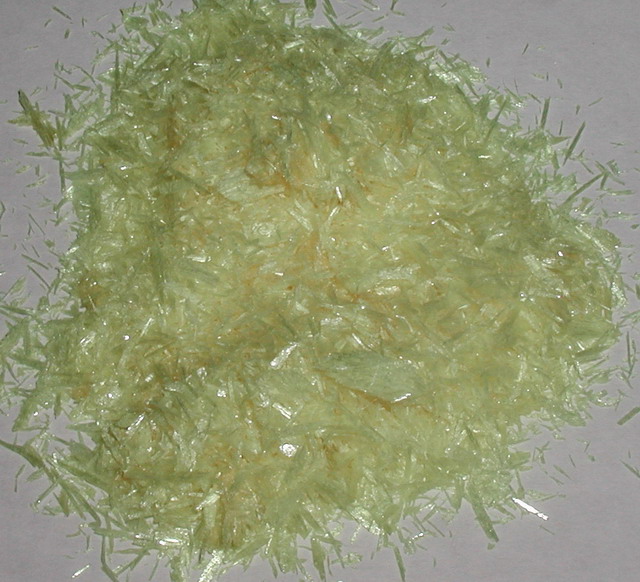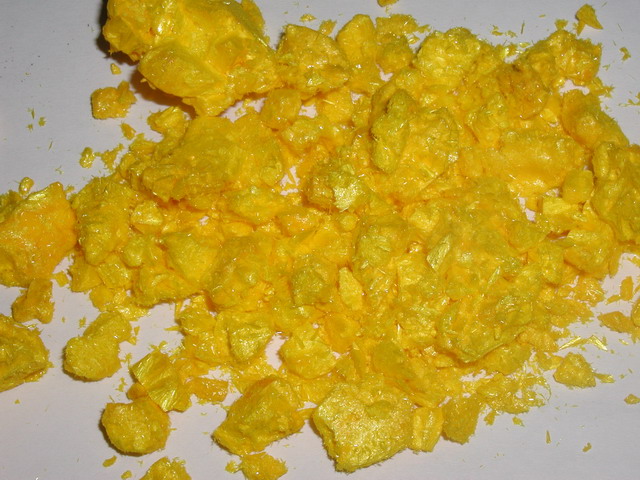(Hive Bee)
06-29-04 04:48
No 516174
(Rated as: excellent)
The condensation of nitroethane with substituted aromatic aldehydes was observed to occur under mild conditions, catalyzed by n-butylamine (5 mol%), producing nitropropenes in excellent yields. The reaction proceeds without a co-solvent or heat, reaching completion in 6-40 days.
Representative procedure:
para-Fluorobenzaldehyde (20.59 g, 166 mmol) was mixed with nitroethane (12.44 g, 166 mmol). Upon addition of n-butylamine (0.61 g, 8.3 mmo), the previously clear solution quickly turned light yellow and gave off a light vapor. The mixture was swirled and set in the dark at room temperature. In two days, droplets of water were seen coagulating on the surface of the mixture. In 13 days, a large crystalline mass had formed out of the mixture. After 20 days the flask contained a solid crystalline mass apparently free of any remaining liquid. The solid was broken up, rinsed with cold deionized water, and recrystallized from boiling isopropyl alcohol to yield 1-(para-fluorophenyl)-2-nitropropene (23.8 g, 132 mmol, 79%) as light yellow platelets.
| Starting material | Amount | Time | Obtained | Yield |
| 4-Fluorobenzaldehyde | 20.59 g | 20 d | 23.8 g | 79% |
| Piperonal | 30.0 g | 6 d | 35.8 g | 87% |
| 2,5-DiMeObenzaldehyde | 10.0 g | 40 d | 12.2 g | 91% |
* In the case of 2,5-DiMeObenzaldehyde, not all of the solid benzaldehyde would initially dissolve in the nitroethane; a small bit of additional nitroethane was used to get everything in solution.
Here's the products (I'm big on pictures, you see):
1-(para-fluorophenyl)-2-nitropropene (finally a decent yield)
1-(3,4-methylenedioxyphenyl)-2-nitroprop
1-(2,5-dimethoxyphenyl)-2-nitropropene
I see no reason why this shouldn't work with nitromethane to produce nitrostyrenes, but I've yet to try that out. ![]()
-SpicyBrown
(Hive Bee)
06-29-04 10:28
No 516255
thats the best yield I've ever heard of for 1-(4-fluorophenyl)-2-nitropropene. Well done!
(Newbee)
06-30-04 00:19
No 516413
Good that you included pictures of the nitropropenes. People should do this more. It ones shows again what a beautiful yellow colors these nitro compounds have. The picture that is shown for 1-(2,5-dimethoxyphenyl)-2-nitropropene looks very similar to the crystalline product I recently obtained.
A little poison now and then: that makes for agreeable dreams.
(Hive Bee)
06-30-04 08:41
No 516505
Thanks starlight and Chemitant -- I agree about the pictures. It used to be kind of a pain in the ass to do, not to mention potentially dangerous, but now that The Hive has the upload feature so one can host their own pictures on the board it's so easy, not to mention worthwhile.
Although the 91% yield of 1-(2,5-dimethoxyphenyl)-2-nitropropene made me quite happy (and trust me, I almost gave up on that one at like the 30 day mark), I was most happy about the 1-(4-fluorophenyl)-2-nitropropene yield. I knew there had to be some way of getting better then 50% on that one..
Does anybody have any ideas why the 1-(2,5-dimethoxyphenyl)-2-nitropropene took so rediculously long to reach completion? I was thinking perhaps the ring methoxy's, by donating electron density to the ring and hence the carbonyl carbon via resonance, may decease the electrophilicity of the carbonyl carbon, making the initial attack by the nitroethane "enolate" less favorable. However, only the ortho methoxy can donate electron density in this manner. This idea fails then in that by the same rationale, piperonal should also be a poor candidate for the same reaction, but that compound went to completion in a mere 6 days. Perhaps it has to do with the elimination of water instead? Hope what I'm trying to say there makes sense, it's late and I'm fumbling words.
-SpicyBrown
(Hive Bee)
07-01-04 15:53
No 516725
First of all: WOW, nice pics & striking yields - congrats!
I don't know if anything changes its "electrophility" when water is kept out of rxn, but I think its removal most surely facilitates the condensation (the reason why the reflux method uses a dean-stark) - the term "Le Chatelier" alway serves well as explanation for me...
(my guess would be that after 20 days, the formed water will have evaporated, thus the dry crystals. Have you tried to cool the rxn in the freezer? This could speed up things if water is the reason for the slow rxn)
Greetz A
"..ein Trank von unterschiedlicher Farbe, in ihm ist Heilung für die Menschen."
(Stranger)
07-01-04 17:59
No 516739
Have I got this right, or am I in need of a flame
would it be possible to use just benzaldehyde instead of the para-Fluorobenzaldehyde
and get some nice nitro alcohols ?
(i want to try and get around tertiary amines)
(Hive Bee)
07-01-04 18:31
No 516746
No, benzaldehyde will result in same compound as p-fluorobenzaldehyde - except that the "p-fluoro" isn't there! With this reaction, nitroalcohols are just an unwanted side product (think you need excess water for makin them) - UT(n)FSE..
A
"..ein Trank von unterschiedlicher Farbe, in ihm ist Heilung für die Menschen."
(Stranger)
07-01-04 19:04
No 516754
Im only getting half sense out of your post
1 im trying to find out if n-butylamine can be used as a catalyst in condensation of benzaldehyde and nitroethane
2 wouldn’t the compound with out the p-fluoro be a nitro alcohol? Or is the nitroethane just sticking randomly to the ring? (Instead of to the group already on there)
3 I was looking for a way around tertiary amines mentioned in the production of nor ephedrine from benzaldehyde (I have UT(n)FSE)
(Hive Bee)
07-01-04 20:06
No 516762
Condensing 4-F-BA with NE yields 4-F-P2NP, whereas condensing plain BA with NE gives plain P2NP. Both can be accomplished with n-butylamine as catalyst. This thing with additional fluoro/methoxy (or other) substituents on the phenyl ring is called "substitution" and different substituents give different amphetamines... (and fluoro-benzaldehyde gives rise to fluoro-subtituted amphetamine through reduction of fluoro-nitropropene, resulting in fluoroamphetamine)
And during the condensation of benzaldehydes with nitroalkanes, the phenyl ring and its substituents are left untouched - the two molecules cling together at the aldehyde group, not at the ring!
SpicyBrown even posted three pictures, showing three different nitropropenes with different substituents on the ring), obtained from three different benzaldehydes (with three different...) - using the same method!! And he even titled them "(subtituent-phenyl)-2-nitropropene", showing that these three different substituents don't make big differences in this case... (and surely no nitroalcohols can be seen in the pics)
To get a nitro alcohol, you can't use above procedure and subtitute 4-F-BA with BA! And you surely won't get any tertiary amine with a knoevenagel condensation..
(guess how I found out once upon a time?? UTFSE! Maybe with "nitroalcohol benzaldehyde"!?)
A
"..ein Trank von unterschiedlicher Farbe, in ihm ist Heilung für die Menschen."
(Hive Bee)
07-01-04 20:37
No 516765
SpicyBrown: something similar was posted time ago by Lino, though he used cyclohexylamine and got 80% yield with plain BA - is this where your idea originates from?
Post 278183 (Lino: "Re: Synthesis of Phenyl-2-Nitropropene", Chemistry Discourse)
Greetz A
"..ein Trank von unterschiedlicher Farbe, in ihm ist Heilung für die Menschen."
(Hive Bee)
07-01-04 21:18
No 516774
Welt:
you can't use n-butylamine or other primary amines as catalysts in the formation of nitroalcohols. These catalysts make nitropropenes when condensing a benzaldehyde (substituted or otherwise) with nitroethane.
If you want to avoid the use of tertiary amines as a catalyst, then you could use the method of Kamlet: ../rhodium /kamlet.
Or you may be able to use KF as a condensation catalyst as in Post 370461 (Barium: "1-(2,4-dimethoxyphenyl)-2-nitropropan-1
07-02-04 05:42
(Rated as: UTF PM Function)
(Heavyweight Chempion(eer))
07-03-04 17:39
No 517183
Nice yields, nice pics, great work.
Severe Aztecoholic and President of Sooty's fanclub - Sooty for President!!